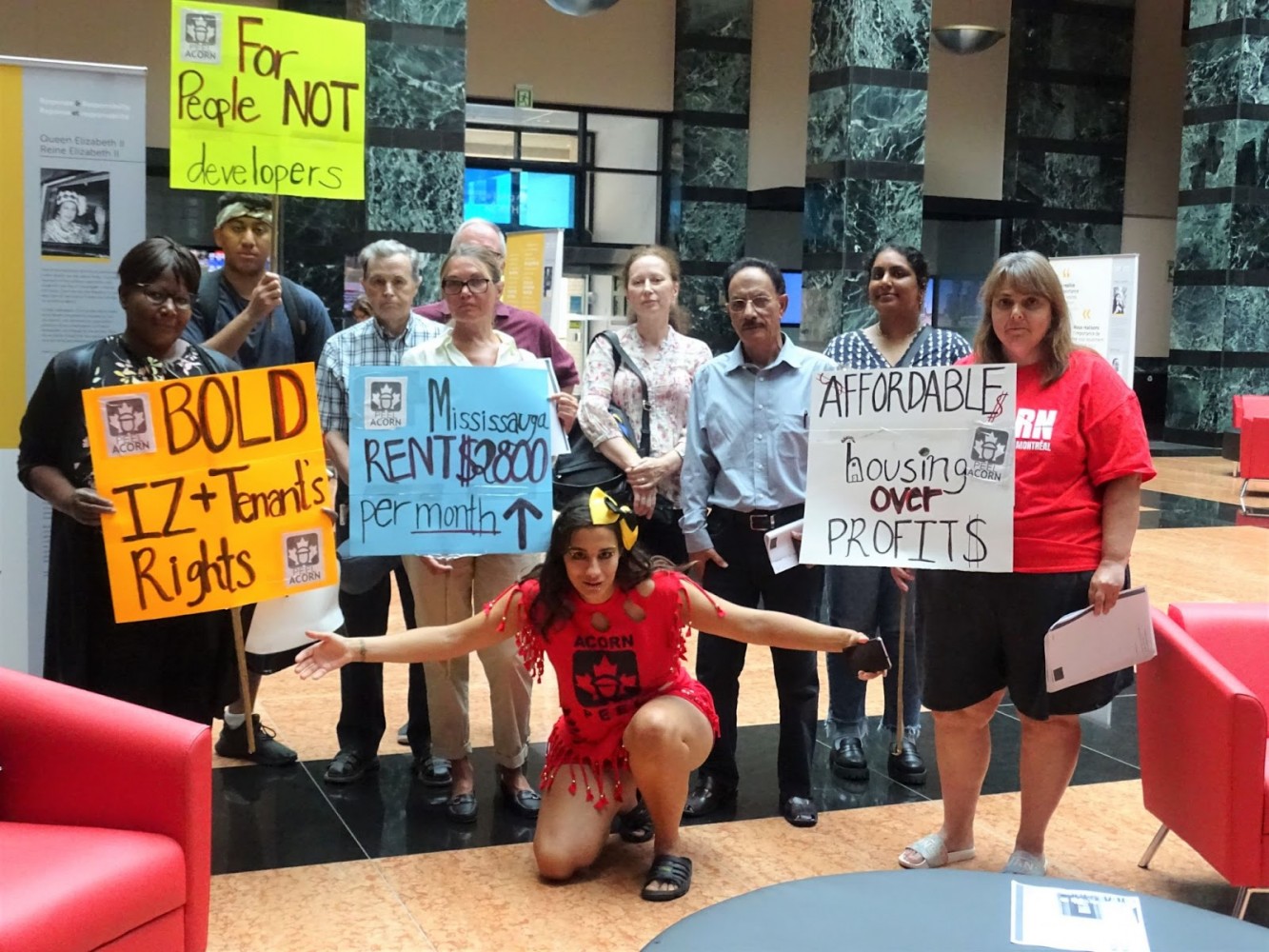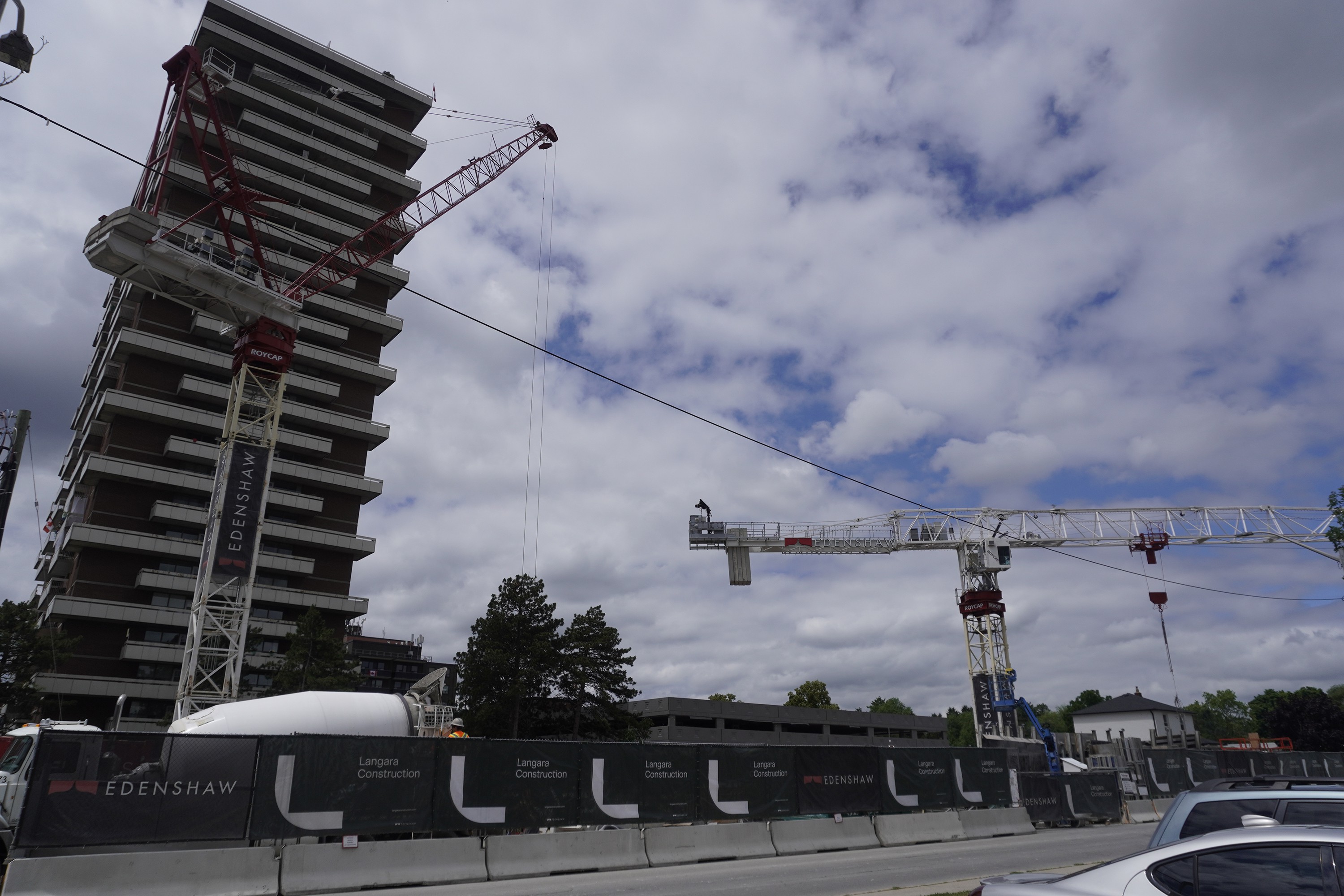
Advocates demand Mississauga take stronger stance as critical affordable housing policy reaches final vote
Mississauga is one vote away from adopting a bylaw that will increase the amount of affordable housing in the city.
The debate around a future inclusionary zoning (IZ) policy has been ongoing for the past few years as planning staff, councillors and local residents have worked together to figure out the best way to force developers into being community builders. Put simply, IZ mandates that development projects in particular areas of the city are required to have a certain number of affordable units.
On August 8, the City’s Planning and Development Committee (PDC) approved the last piece of the IZ puzzle, cementing the policy before it heads to council to be adopted on August 10. The minor change did little to appease community members who continued to push councillors to do more.
The Association of Community Organizations for Reform Now (ACORN) Peel Region chapter has been heavily critical of the IZ policy Mississauga is trying to adopt.
“It's not that you're in the business of housing, it's that you're setting the policy for housing,” Tanya Burkart, a member of Peel ACORN told councillors. “So again, who will you help by how you vote? It's important.”
The organization conducted a survey of 118 Peel ACORN members that reflects the demands heard at multiple IZ public forums and council meetings. The majority of respondents wanted to see a stronger policy that mandates more affordable units; for the area where the policy is applied to be expanded across the entire city as opposed to just surrounding transit stations; and for any future units to be marketed to those with an annual income of $45,000 or less.
The ACORN survey, conducted between May and July 2022, was emailed to all contacts within the ACORN database, but was limited to members in Mississauga and Brampton. Some surveys were conducted by phone.
“Peel ACORN and allies have been pushing the city of Mississauga to adopt a strong IZ bylaw. While the City has held virtual and in-person consultations with communities and developers, at the end of the day, the people are what make the city and their demands must be met,” the survey reads.
Becca Cala, a resident in Cooksville and a member of ACORN Peel, spoke to council about how their decisions impact the public.
“I have Tourette syndrome and I'm very loud,” Cala said. “I have gotten many discriminant eviction notices, I was homeless at 16 for the cumulative total of four years.”
Now Cala lives above a homeless shelter, a unit that was given to her after seven years of being on the centralized housing waitlist. In Peel there are 28,227 households currently on that list.
“We [ACORN Peel] suggested when people are given affordable housing units there's a connected social service that can give them job options for employment as well,” Cala said. “So I can save for my own house and be out of there by 10 years. I will gladly stay there for a short while when I am given the tools to build myself financially and get out of there.”
Becca Cala, a Mississauga resident, told council how difficult it is to rent a unit when she has a disability which forces her to be loud occasionally.
(Natasha O’Neill/ The Pointer)
According to Mississauga’s policy, IZ can only be applied to land within an 800-metre radius of a major transit station area (MTSA). These MTSA designations are dictated by the Region of Peel, which follows the provincial Planning Act. Mississauga staff and council have the power to decide how many units in a new development must be set-aside for affordable housing, and which buildings the policy will apply to—in this case it is any new project with 50 or more housing units.
Mississauga’s policy focuses largely on home ownership and not rental units — something ACORN has pointed out could exclude low income earners from taking advantage of the policy. The new policy dictates that projects surrounding the future Hurontario LRT will be required to have 10 percent affordable housing among them. The City’s plan indicated this percentage will be achieved over time and not right away. Staff have provided no timeline for when they hope to reach this 10 percent target.
The 10 percent threshold will also be applied to the area around Clarkson GO station. Dundas Street—the site of a future bus rapid transit route— will require residential builders to designate seven percent of homes as affordable, and Lakeshore Road East (Dixie, Lakefront, Promenade and Haig) and Ninth Line (Derry and Britannia) will have up to 5 percent of units meet affordable housing criteria.
Mississauga’s inclusionary zoning policy will yield approximately 100 affordable units a year, City staff estimate.
(City of Mississauga)
Approving the new policy is only a first step for Mississauga and will not be a silver bullet to address the affordable housing crisis in Peel, which has grown exceedingly worse as a result of inaction at the regional level and as a result of the COVID-19 pandemic.
Planning staff have confirmed the IZ bylaw will not result in a massive influx of new affordable units each year.
“We have looked at some preliminary analysis of what the set-aside rates would yield,” Catherine Parsons, a planner with Mississauga said at the July 5 PDC meeting. “We think that about a minimum of 100 units per year on an annual basis would be the affordable unit yield.”
A figure advocates say is merely a drop in the bucket.
For example, if a project within the Port Credit MTSA was proposed to include 200 units, about 20 of them under the policy would be designated as affordable.
There are two reasons Mississauga’s IZ policy is so specific. First, the City wants to increase the amount of housing given to what it calls the missing middle, which are households that generally earn between $58,000 and $109,000 annually.
“These households are all struggling to afford market housing, but they typically don't qualify for assistance that's targeted at our lower-income households. So there's a gap there,” Parsons said at a previous public forum.
Targeting IZ toward those looking at homeownership allows the policy to impact middle-income earners. Estimates by the City suggest that under IZ, it will cost about $294,000 for a 1-bedroom, $359,000 for a 2-bedroom and $432,000 for a 3-bedroom home.
In Mississauga the current average price for a 1-bedroom unit is $531,419, a 2-bedroom unit is $606,772 and a 3-bedroom unit is $591,629 as of June 2022.
ACORN advocates have been asking for council to go further and require 20 to 30 percent of units be designated as affordable. It’s unclear whether any GTA city has considered such a strict policy. The City of Toronto, the first city in Ontario to adopt an IZ policy, forced developers in the densest parts of downtown to contribute between 7 and 10 percent, depending on the area.
According to staff, the policy in its current form balances the need to create more affordable housing while limiting the impact on the housing market, but changes are not ruled out in the future.
“The proposed set-aside rates reflect the results of the IZ market feasibility analysis and no changes are recommended at this time. The impact on the market will be monitored to determine if higher or lower set-aside rates are needed in the future,” staff stated.
In December 2021, N. Barry Lyon Consultants Ltd. finalized the market feasibility analysis of IZ in Peel Region. This 92-page report details what the draft IZ implementation would look like in each city and specific growth areas. It also highlights reasons why Mississauga’s IZ policy looks different from Toronto’s and explains how it would affect the housing market locally.
Toronto’s IZ policy includes rental buildings, Mississauga does not, despite a clear indication from past reports that those in poverty turn toward renting rather than homeownership. The report notes that it would not be feasible to apply IZ to rental units because there are simply not enough developers building this type of housing.
The lack of rental units in Peel is clear, with a current vacancy rate hovering around 1.2 percent. A “healthy” rate for a city falls between 3 to 5 percent. It means those lucky enough to obtain rental units in the Region don’t vacate quickly.
Instead of building apartment buildings, many developers are turning to condominium projects, allowing some people to buy and sell units as investment properties, and renting them out to others.
“The investor condominium market has therefore largely fueled the new rental supply in Peel Region, rather than purpose-built rental apartments,” the report reads.
According to the consultants, Mississauga has seen “limited purpose-built rentals” in recent years, and three such buildings completed after 2015 are now experiencing “strong pricing.”
If Mississauga implemented IZ on rental units, staff fear the policy would create another disincentive for developers to build rentals and further exacerbate the vacancy rate.
Another parameter of IZ is how long the units will stay affordable after completion. Originally staff presented a term of 50 years, at which point the unit could be put up for sale at market value. Some advocates at the July 5 planning meeting successfully argued for an extension to 99 years ensuring these units remain affordable for a much longer period of time. It’s a request staff have said is “reasonable” and agreed to the extension.

Few developers in Mississauga are building rental unit apartment buildings.
(Alexis Wright/The Pointer)
“I just wanted to congratulate the ACORN people, their delegations have made a difference,” Councillor Carolyn Parrish said at the August 8 PDC meeting. “I think going to 99 years on ownership and 30 years on rental is largely due to their delegations, and I thank you for your assistance on that."
In August, staff presented council with a 99-year term for homeownership and 25 years for rentals plus a five-year phase-out period.
Rental units are currently exempt from the initial rollout of IZ—there is a potential to include them later— but the policy can apply if delivered through condo units. For example, should an IZ unit be purchased and the buyer looks to rent out the unit as opposed to living in it, there would be stipulations in any ownership agreement that the rental cost must be an affordable rate. This aspect of the IZ policy, along with other practicalities, like who will mandate the sale of these units after the developer is completed the project, and how potential buyers will be selected are still being worked out.
Email: [email protected]
Twitter: @taasha__15
COVID-19 is impacting all Canadians. At a time when vital public information is needed by everyone, The Pointer has taken down our paywall on all stories relating to the pandemic and those of public interest to ensure every resident of Brampton and Mississauga has access to the facts. For those who are able, we encourage you to consider a subscription. This will help us report on important public interest issues the community needs to know about now more than ever. You can register for a 30-day free trial HERE. Thereafter, The Pointer will charge $10 a month and you can cancel any time right on the website. Thank you
Submit a correction about this story


